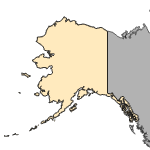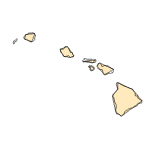Procambarus seminolae
(Seminole crayfish)
Crustaceans-Crayfish
Native Transplant |
|
Common name: Seminole crayfish
Taxonomy: available through
www.itis.gov
Identification: The Seminole Crayfish (Procambarus seminolae) has a predominately dark brown carapace that fades to a greyish tan or cream on its ventral surface. Its claws are olive brown towards their base, which transitions to orange on the propodus and dactyl (fingers), and the chelae (claws) are studded heavily with dark brown tubercles. It bears a broad stripe that is orange to tan in color and spans the median of the carapace from the acumen to the caudal margin (Hobbs 1981). Small, cream colored spots are seen on the head and along the sides of the cephalothorax. The abdomen has a dark median dorsal stripe that narrows towards the telson (tail), and it is flanked by narrower, less prominent, reddish brown stripes. The telson has paired reddish brown spots, a narrow transverse stripe, and a dark margin that is broadest on the caudal base (Hobbs 1981). A comprehensive diagnosis of morphological features needed for further identification is given in Hobbs (1942) and Hobbs (1981), and an illustrated key to identification is provided by Hobbs (1991).
Size: Seminole Crayfish may grow to reach 44 millimeters (mm) in carapace length (CL). First form males have been recorded as small as 22.2 mm CL and as large as 42.8 mm CL (Hobbs 1981).
Native Range: The Seminole Crayfish is native to the states of Florida and Georgia. It can be found distributed from the Ocumlgee, Oconee, and Altamaha River Basins in Georgia, south to the Lower Saint Johns River Basin, and west to Marion County, FL (Hobbs 1958; Hobbs 1981).



|

Alaska |

Hawaii |

Puerto Rico &
Virgin Islands |

Guam Saipan |
Hydrologic Unit Codes (HUCs) Explained
Interactive maps: Point Distribution Maps
Nonindigenous Occurrences:
Table 1. States with nonindigenous occurrences, the earliest and latest observations in each state, and the tally and names of HUCs with observations†. Names and dates are hyperlinked to their relevant specimen records. The list of references for all nonindigenous occurrences of Procambarus seminolae are found here.
Table last updated 12/18/2025
† Populations may not be currently present.
Ecology: The Seminole Crayfish has a broad ecological tolerance and has been found to exploit virtually every type of habitat occupied by other crayfish occurring within its range (Hobbs 1981). It has been collected in habitats from clear streams and flatwood ponds, to stagnant pools and roadside ditches. Procambarus seminolae is frequently found in flatwood systems, where it occupies creeks, ephemeral ponds, and roadside ditches. In creeks, it can often be found concealed in both vegetation and submerged leaf litter. The Seminole crayfish has also been collected from small rivers, but not in high abundances. (Hobbs 1942; Hobbs 1981). In ephemeral ponds and ditches, the Seminole crayfish occupies burrows near the water’s edge. Most burrows of this species are simple, containing an opening at the ground’s surface and another entrance opening to the basin, which is flooded in periods of high water. During droughts, burrows can be seen scattered on the bottom of basins, often clustered around stumps or rocks (Hobbs 1942; Hobbs 1981). Like other crayfish species, P. seminolae may plug their burrow chimneys during the dry season, allowing them to persist in moist bottom for considerable amounts of time. Burrows are found in both ephemeral waters and areas that do not fully dry, and crayfish may occupy them throughout the year in periods of both inundation and drought (Hobbs 1981).
Seasonal collections in Georgia and Florida revealed that pairs of reproductively active (first form) males and females occupied burrows during the spring, summer, and fall. While ovigerous and young bearing females were only found during the months of September, October, and November, first form males were recorded during each month of the year. As a result, it is suspected that ovulation in P. seminolae is confined to the late summer and early fall, and male P. seminolae likely remain reproductively active throughout most of the year (Hobbs 1981). Females carrying eggs or young were only collected from within burrows. The number of eggs carried by females ranged from 146 to 220 and was not proportional to their length (Hobbs 1981).
Means of Introduction: The means of introduction for the Seminole Crayfish into nonindigenous watersheds is unknown.
Status: Hobbs (1981) documented the Seminole Crayfish in Bryant County, GA, disjunct from its known range, and well within the range of Procambarus lunzi. He hypothesized that this collection was the result of an introduction; however, he did not propose any explanations as to how it may have been displaced. Current literature does not indicate whether the Seminole Crayfish persists in the locality where it was collected by Hobbs (1981).
Impact of Introduction: The impacts of this species are currently unknown, as no studies have been done to determine how it has affected ecosystems in the invaded range. The absence of data does not equate to lack of effects. It does, however, mean that research is required to evaluate effects before conclusions can be made.
References: (click for full references)
Hobbs, H.H., Jr. 1942. The crayfishes of Florida. University of Florida, Gainesville, FL.
Hobbs, H.H., Jr. 1958. The evolutionary history of the Pictus group of the crayfish genus Procambarus (Decapoda, Astacidae). Quarterly Journal of the Florida Academy of Sciences 21(1):71-91. https://www.jstor.org/stable/24314991
Hobbs, H.H., Jr. 1981. The crayfishes of Georgia. Smithsonian Contributions to Zoology 318:1-549.
Hobbs, H.H., Jr., and H.H. Hobbs III. 1991. An illustrated key to the crayfishes of Florida (based on first form males). Florida Scientist 54(1):13-24. https://www.jstor.org/stable/24320423
Author:
Procopio, J.
Revision Date: 4/10/2020
Citation Information:
Procopio, J., 2025, Procambarus seminolae Hobbs, 1942: U.S. Geological Survey, Nonindigenous Aquatic Species Database, Gainesville, FL, https://nas.er.usgs.gov/queries/FactSheet.aspx?speciesID=219, Revision Date: 4/10/2020, Access Date: 12/19/2025
This information is preliminary or provisional and is subject to revision. It is being provided to meet the need for timely best science. The information has not received final approval by the U.S. Geological Survey (USGS) and is provided on the condition that neither the USGS nor the U.S. Government shall be held liable for any damages resulting from the authorized or unauthorized use of the information.